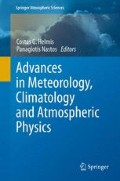Abstract
Drought is the least understood of all weather phenomena, since it differs from other natural hazards in several ways. The hazardous of drought can be better understood by analyzing drought indices. The Standardized Precipitation Index (SPI) has been one of the most widely used indices for drought studies, as it can provide satisfactorily results for the appearance, variability and intensity of drought. Moreover, SPI has been developed in order to quantify and record drought episodes on multiple time scales (3 months, 6 months, 1 year, 2 years). In the present study a statistical downscaling technique based on artificial neural network was employed for the estimation of SPI over Greece. The aim of the study is to evaluate the simulated SPI index against the observational one. The performance of the statistical downscaling model is assessed utilizing biases, standard deviation and correlation coefficient between observed and simulated indices. An overestimation of the simulated mean SPI indices accompanied by a decrease in standard deviation is evident for all stations and all time periods. The reproduction of SPI3 and SPI6 for winter, spring seasons display rather promising results.
Access this chapter
Tax calculation will be finalised at checkout
Purchases are for personal use only
References
Alexanderson H (1986) A homogeneity test applied to precipitation data. J Climatol 6:661–675
Anagnostopoulou C (2003) A contribution of drought analysis in Greece. Ph.D. dissertation, Aristotle University of Thessaloniki, Thessaloniki, 215pp
Giorgi F (1995) Perspectives for regional earth system modelling. Global Planet Change 10:23–43
Hayes M (1999) Drought indices, National Drought Mitigation Center. (Available on line: http://www.civil.utah.edu/~cv5450/swsi/indices.htm#deciles
IPCC (2007) IPCC fourth assessment report: climate change 2007. Working group I report, “the physical science basis”, Chapter 11 “Regional climate projections”. pp 847–940
Kalnay E, Kanamitsou M, Kistler R, Collins W, Deaven D, Gandin L, Irebell M, Saha S, White G, Woollen J, Zhu Y, Leetmaa A, Reynolds R, Chelliah M, Ebisuzaki W, Huggins W, Janowiak J, Mo KC, Ropelewski C, Wang J, Jenne R, Joseph D (1996) The NCEP/NCAR 40-year Reanalysis project. Bull Amer Meteor Soc 77:437–471
Lana X, Serra C, Burgueno A (2001) Patterns of monthly rainfall shortage and excess in terms of the Standardized Precipitation Index for Catalonia (Spain). Int J Climatol 21:1669–1691
Loukas A, Vasiliadis L, Tzabiras J (2007) Evaluation of climate change on drought impulses in Thessaly, Greece. Eur Water J 1:17–18
McKee TB, Doesken NJ, Kleist J (1993) The relationship of drought frequency and duration to time scale. In: Proceedings of the 8th conference of applied climatology, American Meteorological Society, Boston, pp 179–184
Palmer WC (1965) Meteorological drought. Research paper no. 45, U.S. Department of Commerce Weather Bureau, Washington, DC
Palmer WC (1968) Keeping track of crop moisture conditions, nationwide: the new crop moisture index. Weatherwise 21:156–161. doi:10.1080/00431672.1968.9932814
Thom HCS (1958) A note on the gamma distribution. Mon Weather Rev 86:117–122
Tolika K, Maheras P, Vafiadis M, Flocas HA, Arseni-Papadimitriou A (2007) Simulation of seasonal precipitation and raindays over Greece: a statistical downscaling technique based on artificial neural networks (ANNs). Int J Climatol 27:861–881. doi:10.1002/joc.1442
Vasiliadis L, Loukas A, Patsonas G (2009) Evaluation of a statistical downscaling procedure for the estimation of climate change impacts on droughts. Nat Hazards Earth Syst Sci 9:879–894. doi:10.5194/nhess-9-879-2009
Author information
Authors and Affiliations
Corresponding author
Editor information
Editors and Affiliations
Rights and permissions
Copyright information
© 2013 Springer-Verlag Berlin Heidelberg
About this paper
Cite this paper
Anagnostopoulou, C., Tolika, K., Maheras, P. (2013). Drought Index Over Greece as Simulated by a Statistical Downscaling Model. In: Helmis, C., Nastos, P. (eds) Advances in Meteorology, Climatology and Atmospheric Physics. Springer Atmospheric Sciences. Springer, Berlin, Heidelberg. https://doi.org/10.1007/978-3-642-29172-2_54
Download citation
DOI: https://doi.org/10.1007/978-3-642-29172-2_54
Published:
Publisher Name: Springer, Berlin, Heidelberg
Print ISBN: 978-3-642-29171-5
Online ISBN: 978-3-642-29172-2
eBook Packages: Earth and Environmental ScienceEarth and Environmental Science (R0)

